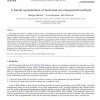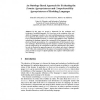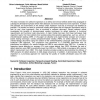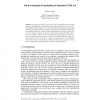532 search results - page 40 / 107 » The UML as a Formal Modeling Notation |
JSS
2006
13 years 7 months ago
2006
Estimating software size is a difficult task that requires a methodological approach. Many different methods that exist today use distinct abstractions to depict a software system...
UML
2005
Springer
14 years 1 months ago
2005
Springer
In this paper we present a framework for the evaluation and (re)design of modeling languages. We focus here on the evaluation of the suitability of a language to model a set or rea...
JSS
2000
13 years 7 months ago
2000
The basic motivation for software inspections is to detect and remove defects before they propagate to subsequent development phases where their detection and removal becomes more...
SFM
2004
Springer
14 years 1 months ago
2004
Springer
This paper provides an overview of the foundations of the run-time semantics underlying the Unified Modeling Language as defined in revision 2.0 of the official OMG standard. One o...
CAISE
2001
Springer
14 years 8 days ago
2001
Springer
The UML lacks precise and formal foundations for several constructs such as transition guards or method bodies, for which it resorts to semantic loopholes in the form of “uninter...




